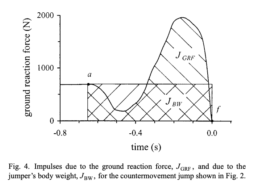Impulse definition and calculation
When a force is applied to a body, the resulting motion of the body is dependent not only on the magnitude of the applied force but also on the duration of force application. The product of force and time (t) is known as impulse :
Impulse = Force * Δt
When a vertical jump is performed on a force platform, a graphical display of the vertical GRF across time can be generated. Since impulse is the product of force and time, the impulse is the area under the force–time curve.
The larger the impulse generated against the floor, the greater the change in the performer’s momentum, and the higher the resulting jump.
Theoretically, impulse can be increased by increasing either the magnitude of applied force or the time interval over which the force acts.
Practically, however, when time of force application against the ground is prolonged during vertical jump execution, the magnitude of the force that can be generated is dramatically reduced, with the ultimate result being a smaller impulse.
For performing a maximal vertical jump, the performer must maximize impulse by optimizing the trade-off between applied force magnitude and force duration.

